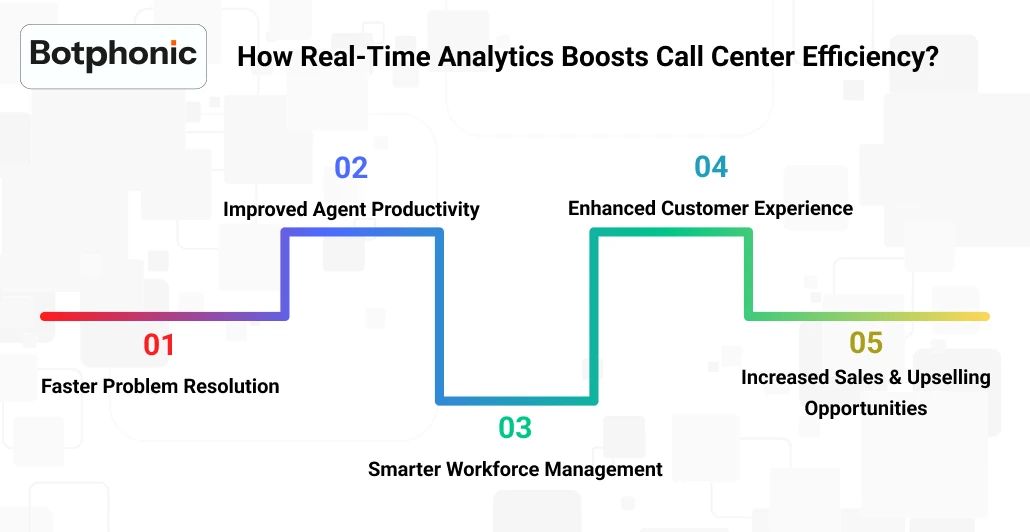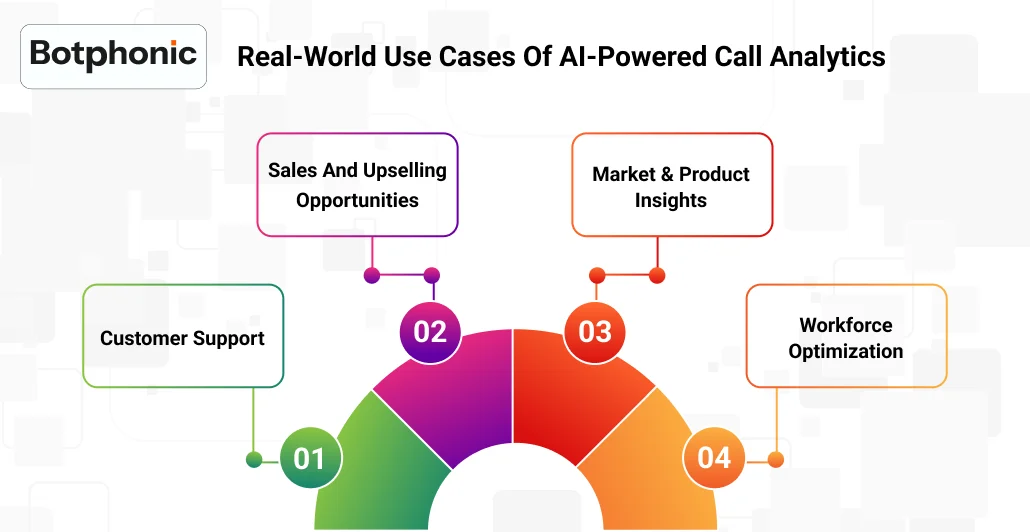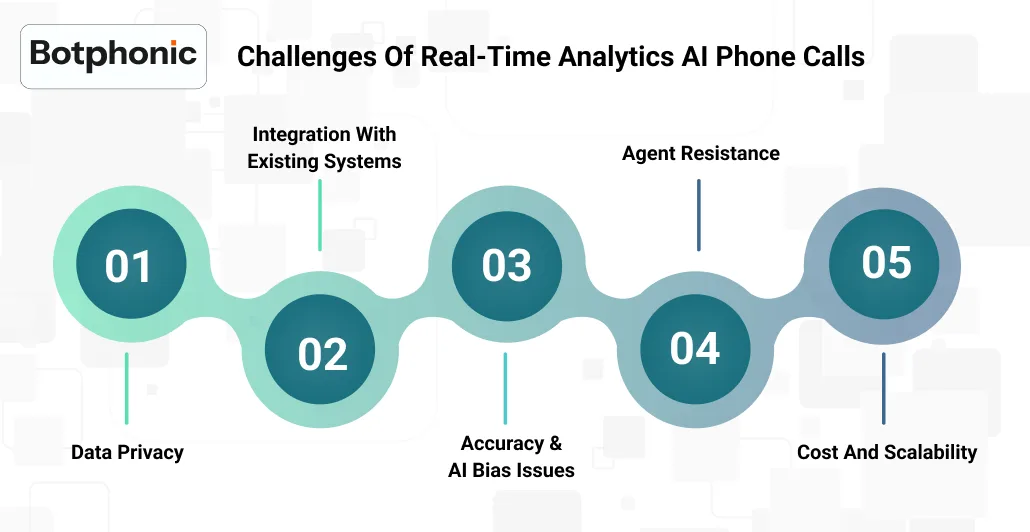
Summarize Content With:
Quick Summary
Tired of tracking every call and listening to records post-call to get proper insights of the customer interaction. Let us tell you about real-time analytics AI phone calls, which share details in real-time, while the interaction is in continuation. We are not just stopping here, in this blog, we will tell you about:
- What is real-time analytics?
- How does it boost efficiency?
- Real-world use cases
- Challenges of Real-time analytics AI phone calls
Introduction
In today’s fast-forward business environment, real-time analytics AI phone calls are helping businesses boost their company and eventually leading to growth. Analyzing calls helps businesses gain the voice of customers. Real-time analytics AI phone calls are helping call centers grow gradually and help track them track KPI metrics, all while the call is still going on. Even with proper sentiment analysis, it can present an upsell opportunity and even lead to cross-sales opportunities. Let’s read about this in detail and get into it.
What is Real-Time Call Center Analytics AI Phone Calls?
Real-time call center analytics AI phone calls refer to optimizing AI and speech analytics to track, process, and analyze interactions that occur during phone calls with customers in the call center. With the incorporation of AI-driven speech recognition and natural language processing, the system successfully records the interaction and understands the given context, sentiment, and keywords added in real time.
The monitoring analytics dashboard offers users to see live metrics regarding calls, for instance, the call quality, customer emotions, and even agent performance.
Key Features
- Live Transcription: Shares speech-to-text format of live conversations in real-time.
- Emotions and Sentiment Analysis: Perceives customers’ tone and mood accordingly.
- Agent Assistance: Provides knowledge-base articles, scripts, and even helps with upsell prompts during the call.
- Compliance Monitoring: Monitors effectively and ensures agents are using required phases and aren’t using prohibited languages.
- Performance Metrics: Assists in tracking call length, first-call resolution, interruption frequency, NPS (Net Promoter Score), CSAT (Customer Satisfaction Score), etc.
- Supervisor Alerts: If there’s a call escalation, the supervisor will get instant real-time notifications.
How Real-Time Analytics Boosts Call Center Efficiency?

Real-time analytics optimize AI-powered tools, natural language processing, and speech recognition. Moreover, these elements help in analyzing calls while they are still in process. Making it easier to track all the call metrics, as rather than waiting for post-call reports, call centers are able to get quick insights. Additionally, these AI call assistant also help create a strategy that improves customer experience and overall performance.
Let’s see some of the key ways it helps call centers boost efficiency.
1. Faster Problem Resolution
- As soon as the customer states their problem, AI pulls up relevant solutions, FAQs, or even other knowledge-based articles for the agent to share.
- By effectively sharing answers, agents spend less time on answers, which directly reduces average handle time and increases operational efficiency.
- As the problems are solved during the first interaction itself, it reduces the chances of follow-ups.
2. Improved Agent Productivity
- Providing real-time coaching, the analytics tool helps share instant prompts to agents.
- Monitoring conversations, AI ensures that the system is following approved scripts and guidelines.
- With AI assistance, new agents can easily learn on the job, reducing onboarding time.
3. Smarter Workforce Management
- The system allows supervisors to see real-time KPIs, for instance, wait times, call volume, customer sentiment, etc.
- Based on call demand, managers can adjust staffing levels based on call demand.
- Supervisors can step in between calls or even share instant coaching tips with voice agents during call escalation.
4. Enhanced Customer Experience
- With AI sentiment analysis, the system is able to perceive customers’ emotions, such as voice tone, pace, and keywords, too.
- With proper customer sentiment analysis, agents can adjust their approach as per the customer’s behaviour, which might help enhance NPS (Net Promoter Score).
- Real-time insights enable agents to share tailored solutions as per customers’ needs.
5. Increased Sales & Upselling Opportunities
- Immediate intent detection and customer sentiment analysis, AI can alert agents if they sense customers’ interest in a particular product or service.
- With real-time updates regarding call KPIs, agents can share real-time prompts for significant cross-sell.
- Along with conversation tracking, managers can easily track which strategies are working best in real time and increase CSAT (Customer Satisfaction Score).
With AI calling and real-time analytics, they help call centers transform into highly efficient and proactive operations. Enabling faster operations, smarter agents, and even enhanced customer experience gives businesses an essential competitive edge.
Real-World Use Cases of AI-Powered Call Analytics

AI-driven call analytics are helping to transform the way contact centers operate. Combining speech recognition, machine learning, and natural language processing lets businesses analyze phone calls in real time and share all the valuable insights.
Let’s get into some practical, real-world use cases and how it benefits:
1. Customer Support
- Analyzing ongoing calls and identifying customers’ intents, lets AI share relevant and most useful solutions to consumers’ problems.
- Benefits: Provides faster resolution to problem and reduces average handle time.
2. Sales and Upselling Opportunities
- AI easily detects signals that show customers’ interest in any particular product or service by interpreting tone shifts or a specific keyword added in the system.
- Benefits: Effectively boost conversion rates and average revenue per call.
3. Market & Product Insights
- AI collects all the data and organizes it accordingly to identify recurring customer complaints or competitors’ mentions.
- Benefits: Offers competitive intelligence and also customer-driven product innovation.
4. Workforce Optimization
- Real-time dashboards allow managers to monitor call volume trends and adjust staffing on the fly.
- Benefits: Reduces waiting times, enhances resource utilization, and even increases operational efficiency.
Challenges of Real-time Analytics AI Phone Calls

Even though all the AI systems are made to offer huge benefits but for successful adoption, they require facing certain challenges. Let’s see what those are and also the best practices to follow, which ensure maximum ROI and smooth integration.
Challenges of Real-Time Call Analytics
1. Data Privacy: Customer calls usually carry sensitive personal or financial information, which demands strict data handling. Mishandling that data can lead to loss of trust and compliance violations.
2. Integration with Existing Systems: There are numerous call centers who use CRM, workforce management tools, and IVR; integrating these with AI analytics can be complex and expensive. Poor integration can lead to inconsistent insights and data silos.
3. Accuracy & AI Bias Issues: Speech recognition might not be able to catch correct words due to accents, dialects, or even background noise, and even the sentiment analysis can get biased due to training data.
4. Agent Resistance: With real-time analytics implementation, agents might feel monitored or micro-managed, which might further lead to low morale and decreased engagement.
5. Cost and Scalability: Implementing AI-powered analytics initially requires major investment in software, cloud infrastructure, and even training human staff, as well as an AI voice agent.
Contact us today to know how our AI-powered solutions can enhance your call center efficiency
Try Now!!Conclusion
Real-time analytics AI phone calls have become something that’s not just providing the insight about call details, but a helper who helps in business strategy effectively. Agent coaching and supervisor assistance provide automated quality assurance and lessen the stress on the staff’s shoulders. With an AI learning management system and call center transcription, the system allows agents to see the conversation insights in real-time and even lets agents intervene if there’s any fragility is detected from the customer’s end.
AI systems help scale effectively with strategic insights and implementation that leads businesses to grow and have a required competitive edge by knowing occurring market trends and customers’ behaviour.

